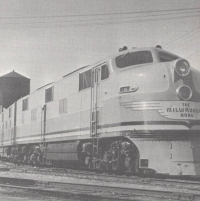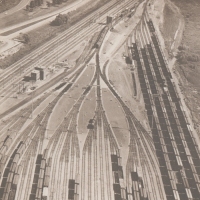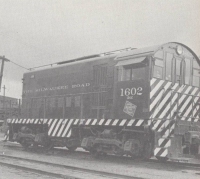|
Despite this patronage and
other favorable developments on the operating side of the railroad,
financial troubles continued to pile up. In June of 1935, the Milwaukee
again filed a bankruptcy petition and then was operated under a
trusteeship, not coming out of bankruptcy through reorganization until
December 1, 1945.
 During the
early 40’s, the Milwaukee Road—and other railroads—did an awesome job of
moving troops, materials and supplies for World War II. After the war came
the relative prosperity of a postwar period. During the
early 40’s, the Milwaukee Road—and other railroads—did an awesome job of
moving troops, materials and supplies for World War II. After the war came
the relative prosperity of a postwar period.
In 1950, the Milwaukee
celebrated its centennial, dating its history to that first train that ran
in Wisconsin in 1850.
Not long afterward, the
company embarked on a program of rebuilding freight yards into new,
completely m o d e r n gravity-type freight classification yards, where
most switching is done by a combination of hump and retarders. The Airline
Yard in Milwaukee was opened in 1952, the huge Bensenville yard west of
Chicago was rebuilt in 1953 and the St. Paul yard opened in 1956. program of rebuilding freight yards into new,
completely m o d e r n gravity-type freight classification yards, where
most switching is done by a combination of hump and retarders. The Airline
Yard in Milwaukee was opened in 1952, the huge Bensenville yard west of
Chicago was rebuilt in 1953 and the St. Paul yard opened in 1956.
In 1955, the Milwaukee began
operating the famous “Cities” trains over Milwaukee trackage between
Chicago and Omaha, in an operation reminiscent of such famous— but by then
vanished trains—as the Pacific Limited and others. The “Cities” are the
City of
Los Angeles, City of San Francisco, City of Denver, City of Portland and
the coach train, the Challenger.
 It
also was in 1955 that the Milwaukee ran its last regularly scheduled steam
locomotive, although the final steam run wasn’t to be made until March 16,
1957, since a few steam locomotives were kept for standby service after
1955. It
also was in 1955 that the Milwaukee ran its last regularly scheduled steam
locomotive, although the final steam run wasn’t to be made until March 16,
1957, since a few steam locomotives were kept for standby service after
1955.
Again, the Milwaukee was to
find that property improvements and progress came side-by-side with
financial problems—although the 50’s brought not disaster, but a decline.
This was true in general of the entire railroad industry, not just the
Milwaukee.
Several related reasons were
behind the decline. One was that railroads, completely regulated and
completely unsubsidized, were competing with modes of transportation that
were mostly unregulated and that received direct or indirect subsidies
from government funds. This competition grew in almost direct ratio to the
rising level of Federal spending on airways, waterways and highways. For
example, in a period when Federal waterway spending increased by four
times, the ton-mile volume of barge lines also quadrupled.
It should be recognized,
too, that the railroad industry had some other built-in problems that had
largely been ignored during the postwar prosperity. This was shown in the
railroad industry’s share of total intercity freight traffic, which fell
from nearly 70% in 1944 to only 41% in 1962.
The passenger traffic
decline continued in the 40’s and 50’s, primarily because of the inroads
of automobile travel, partly because of the airplane. The family car’s
share of intercity passenger travel rose from a wartime low of 58% in 1944
to about 90% in 1962.
From the late 50’s to 1961,
railroad industry employment was cut by one-third, industry net income
fell by 58% and the industry’s freight revenues dropped significantly,
even though these were years when the nation’s overall freight traffic
volume was growing strongly. Then the Milwaukee—and other railroads—began
to fight back. |
